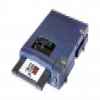The Zip drive is a medium-capacity removable disk storage system, introduced by Iomega in late 1994. Originally it had a capacity of 100 MB, but later versions increased this to first 250 MB and then 750 MB.
The format became the most popular of the super-floppy type products but never reached the status of a quasi-standard to replace the 3.5-inch floppy disk. It has been quickly superseded by flash drive systems as well as rewritable CDs and DVDs, and is practically not in use anymore. The Zip brand was also used for internal and external CD writers known as Zip-650 or Zip-CD.
The Zip system is based loosely on Iomega's earlier Bernoulli Box system; in both systems, a set of read/write heads mounted on a linear actuator flies over a rapidly spinning floppy disk mounted in a sturdy cartridge. The Zip disk uses smaller media (about the size of a 9 cm (3½") microfloppy, rather than the Compact Disc-sized Bernoulli media), and a simplified drive design that reduced its overall cost.
This resulted in a disk that has all of the 9 cm (3½") floppy's convenience, but holds much more data, with performance that is much quicker than a standard floppy drive (though not directly competitive with hard drives). The original Zip drive had a data transfer rate of about 1 megabyte/second and a seek time of 28 milliseconds on average, compared to a standard 1.44 MB floppy's 500 kbit/s (62.5 kB/s) transfer rate and several-hundred millisecond average seek time. Today's average 7200 RPM desktop hard drives have average seek times of around 8.5–9 ms.
Early generation Zip drives were in direct competition with the SuperDisk or LS-120 drives, which held 20% more data and could also read standard 3½" 1.44 MB diskettes, but they had a lower data transfer rate due to lower rotational speed. The rivalry was over before the dawn of the USB era.
Zip drives have been made with a variety of interfaces to the computer. Internal drives have been made with ATA and SCSI interfaces. External drives have been made with parallel port and SCSI and (some years later) USB interfaces. For a while, there was a drive called the Zip Plus which was supposed to be able to autodetect between parallel and SCSI, but there were lots of compatibility problems reported and the drive was later dropped. The Zip Plus drive included additional software and a smaller power adapter than the original Zip drives. Eventually, USB Zip drives came to be powered from their USB connections.
The initial Zip system was introduced with a capacity of 100 megabytes. Plans were considered for a lower cost 25 MB version that would work in the same 100 MB drive — the idea being to bring the price of a Zip disk closer to that of an ordinary floppy — but these disks were never released. The introduction of the 100 megabyte disk quickly made Zip a success and people used them to store files larger than the 1.44 MB capacity of regular floppy disks. As time went on, Iomega eventually increased the capacity to 250 and later 750 megabytes- that is to say, over 500 times as much as a 1.44MB standard high-density 3.5 inch floppy diskette- while at the same time boosting disk acces speed.
Zip media are thicker and slightly wider than 3.5" (9 cm) floppy disks. The extra thickness allows space for centrifugal force to hold the rotating disk away from its protective shell at high speeds, eliminating friction heat that limited the RPM (and therefore transfer speeds) of previous generations of magnetic media diskettes. This non-contact approach also increases the theoretical life of the media.
The underside of Zip media cases include a retroreflective spot in one corner. The drive mechanism will not engage if the reflective spot is not detected. This was a measure to reduce counterfeit low cost media from undercutting Iomega's profits (as the reflective inserts were used under license). Note that higher capacity disks, 250MB and 750MB, do not have the same reflective spot as the 100MB disk.
Zip disks are traditionally packed in clear plastic, two-piece jewel cases similar to those used by smaller MiniDisc media. They are somewhat thinner than standard (three-piece) CD jewel cases, but still thicker than slimline CD cases. When compared to conventional floppy disks, these Zip disks feature the same 3.5 inch area, but are somewhat thicker and weigh nearly three times as much.

